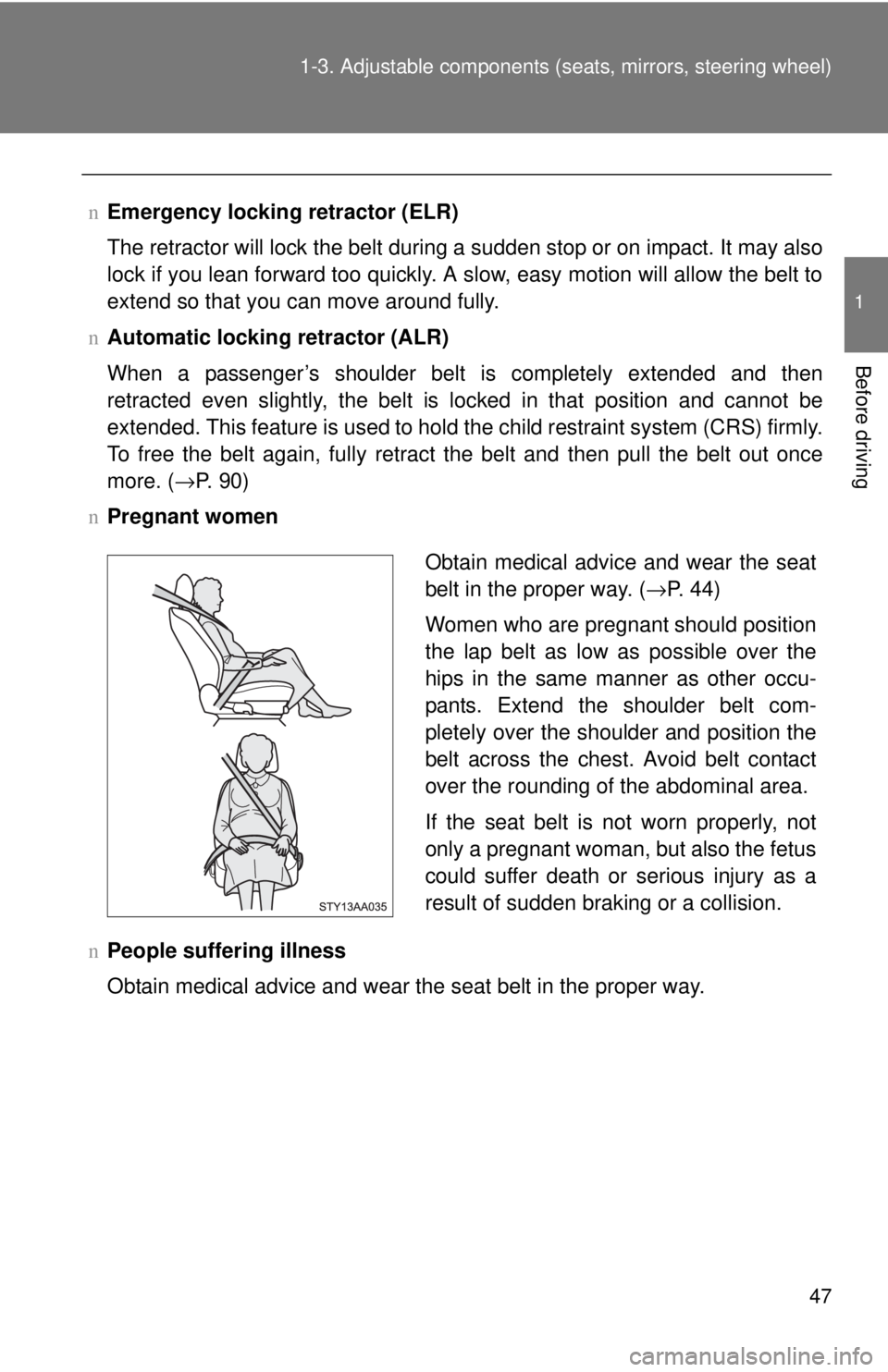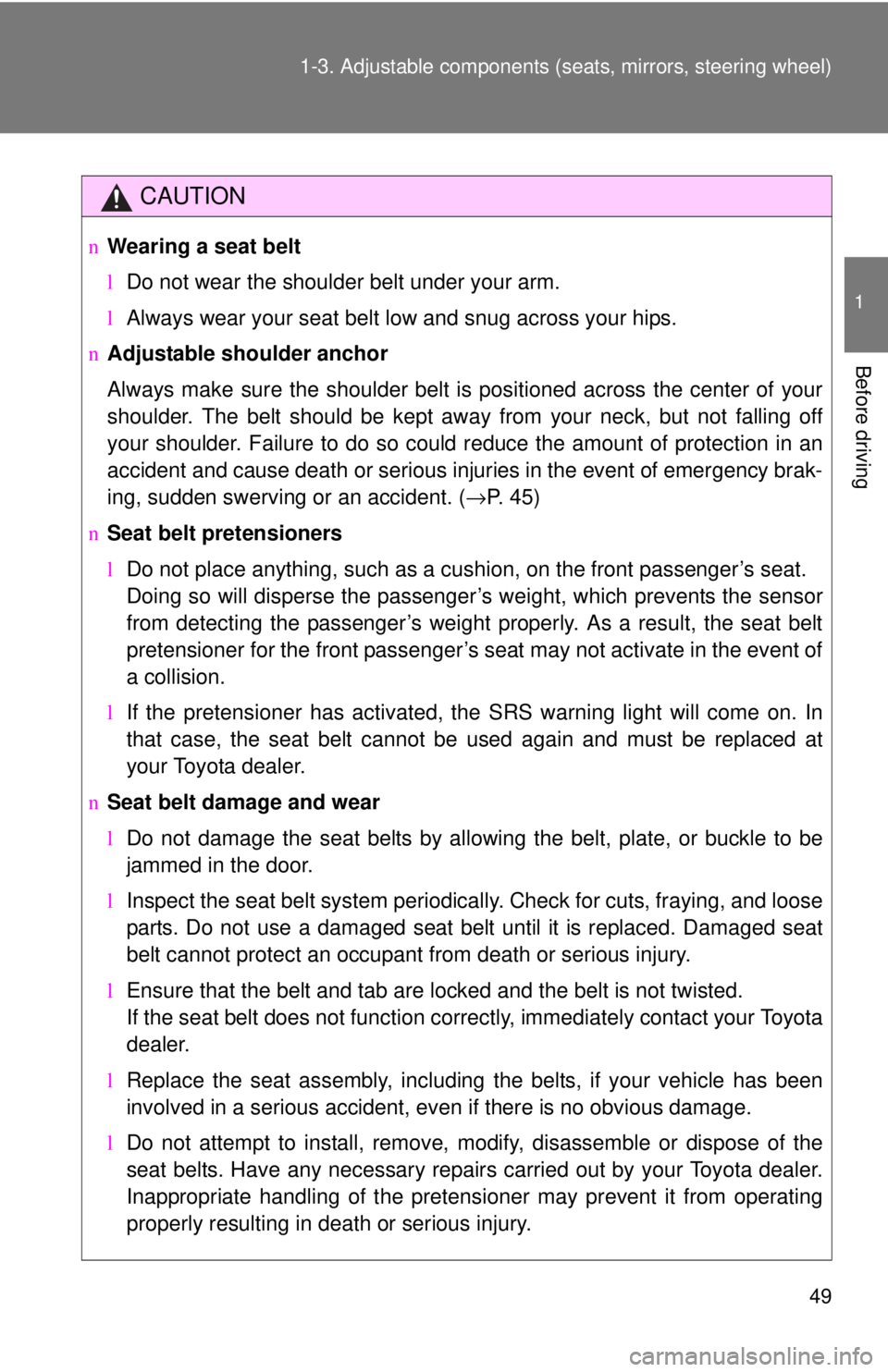Page 53 of 386
39
1-3. Adjustable components (s
eats, mirrors, steering wheel)
1
Before driving
nReturning rear seatbacks
Lower each head restraints
while pushing the lock release
button.
Fold the seatbacks down
while pulling the seatback lock
release knobs.
Tilt the rear seatback up until it locks,
making sure that you hold the seat belt to
prevent it from getting caught between
the seatback and the inner side of the
vehicle.
Make sure the shoulder belt passes
through the guide and the seat belt
is in the position before folding
down the seat when returning the
seatback up.
Page 54 of 386
40 1-3. Adjustable components (seats, mirrors, steering wheel)
CAUTION
nAfter returning the seatback to the upright position
Observe the following precautions. Failure to do so may result in death or
serious injury.
l Check that the seat belts are not twisted or caught under the seat.
lMake sure that the seatback is
securely locked in position by lightly
rocking it back and forth.
If the seatback is not securely locked,
the red marking will be visible on the
seatback lock release knob. Make
sure that the red marking is not visi-
ble.
Page 55 of 386
41
1
1-3. Adjustable components (seats, mirrors, steering wheel)
Before driving
Head restraints
nRemoving the head restraints
Front seats
Head restraints are provided for all seats.
Front seats
Vertical adjustment
Up
Pull the head restraints up.
Down
Push the head restraints down
while pushing the lock release
button.
Rear seats Vertical adjustment
Up
Pull the head restraints up.
Down
Push the head restraints down
while pushing the lock release
button.
Lock release button
Lock release button
Pull the head restraint up while pushing
the lock release button.
Page 56 of 386
42 1-3. Adjustable components (seats, mirrors, steering wheel)
Rear seats
n Installing the head restraints
Front seats
Rear seats
n Adjusting the height of the head restraints
Pull the head restraint up while pushing
the lock release button.
Align the head restraint with the installa-
tion holes and push it down to the lock
position.
Press and hold the lock release button
when lowering the head restraint.
Align the head restraint with the installa-
tion holes and push it down to the lock
position.
Press and hold the lock release button
when lowering the head restraint.
Make sure that the head restraints are
adjusted so that the center of the head
restraint is closest to the top of your ears.
Page 57 of 386
43
1-3. Adjustable components (s
eats, mirrors, steering wheel)
1
Before driving
nAdjusting the rear seat head restraints
Always raise the head restraint one level from the stowed position when
using.
CAUTION
nHead restraint precautions
Observe the following precautions regarding the head restraints. Failure to
do so may result in death or serious injury.
lUse the head restraints designed for each respective seat.
l Adjust the head restraints to the correct position at all times.
l After adjusting the head restraints, push down on them and make sure
they are locked in position.
l Do not drive with the head restraints removed.
Page 59 of 386
45
1-3. Adjustable components (s
eats, mirrors, steering wheel)
1
Before driving
Rear center seat belt
The rear center seat belt is a 3-po int type restraint with 2 buckles. Both
seat belt buckles must be correctly located and securely latched for
proper operation.
Make sure that the buckle is
securely latched for ready use of
the center seat belt.Matches the tab with the
hooked end
Matches the tab with the con-
cave end
Releasing the belt
Press the release button.
nAdjusting the height of the belt (front seats)
Down
Pull the lock release knob and
slide the height adjuster down.
Up
Move the height adjuster up as
needed until you hear a click.
Page 61 of 386

47
1-3. Adjustable components (s
eats, mirrors, steering wheel)
1
Before driving
nEmergency locking retractor (ELR)
The retractor will lock the belt during a sudden stop or on impact. It may also
lock if you lean forward too quickly. A slow, easy motion will allow the belt to
extend so that you can move around fully.
n Automatic locking retractor (ALR)
When a passenger’s shoulder belt is completely extended and then
retracted even slightly, the belt is locked in that position and cannot be
extended. This feature is used to hold the child restraint system (CRS) firmly.
To free the belt again, fully retract the belt and then pull the belt out once
more. ( →P. 90)
n Pregnant women
n People suffering illness
Obtain medical advice and wear the seat belt in the proper way.
Obtain medical advice and wear the seat
belt in the proper way. ( →P. 44)
Women who are pregnant should position
the lap belt as low as possible over the
hips in the same manner as other occu-
pants. Extend the shoulder belt com-
pletely over the shoulder and position the
belt across the chest. Avoid belt contact
over the rounding of the abdominal area.
If the seat belt is not worn properly, not
only a pregnant woman, but also the fetus
could suffer death or serious injury as a
result of sudden braking or a collision.
Page 63 of 386

49
1-3. Adjustable components (s
eats, mirrors, steering wheel)
1
Before driving
CAUTION
nWearing a seat belt
lDo not wear the shoulder belt under your arm.
l Always wear your seat belt low and snug across your hips.
n Adjustable shoulder anchor
Always make sure the shoulder belt is positioned across the center of your
shoulder. The belt should be kept away from your neck, but not falling off
your shoulder. Failure to do so could reduce the amount of protection in an
accident and cause death or serious injuries in the event of emergency brak-
ing, sudden swerving or an accident. ( →P. 45)
n Seat belt pretensioners
lDo not place anything, such as a cushion, on the front passenger’s seat.
Doing so will disperse the passenger’s weight, which prevents the sensor
from detecting the passenger’s weight properly. As a result, the seat belt
pretensioner for the front passenger’s seat may not activate in the event of
a collision.
l If the pretensioner has activated, the SRS warning light will come on. In
that case, the seat belt cannot be used again and must be replaced at
your Toyota dealer.
n Seat belt damage and wear
lDo not damage the seat belts by allowing the belt, plate, or buckle to be
jammed in the door.
l Inspect the seat belt system periodically. Check for cuts, fraying, and loose
parts. Do not use a damaged seat belt until it is replaced. Damaged seat
belt cannot protect an occupant from death or serious injury.
l Ensure that the belt and tab are locked and the belt is not twisted.
If the seat belt does not function correctly, immediately contact your Toyota
dealer.
l Replace the seat assembly, including the belts, if your vehicle has been
involved in a serious accident, even if there is no obvious damage.
l Do not attempt to install, remove, modify, disassemble or dispose of the
seat belts. Have any necessary repairs carried out by your Toyota dealer.
Inappropriate handling of the pretensioner may prevent it from operating
properly resulting in death or serious injury.